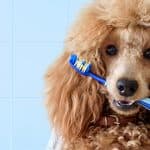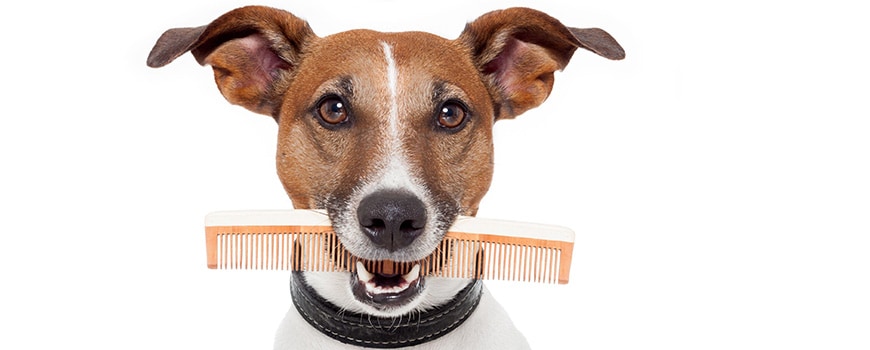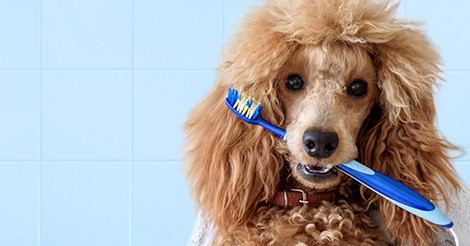Clean teeth and healthy gums are important to your Poodle’s general health. Periodontal disease is one of the most common canine health problems. Veterinary studies have found that periodontal disease is the most widespread disease of any kind in dogs; it is present in approximately 85 percent of all small animals over six years of age.
The studies conclude, however, that frequent and correct oral hygiene is the best way to prevent tooth problems. Therefore, by incorporating regular dental care into your grooming routine, you can help keep your Poodle’s mouth healthy and his breath fresh.
Like humans and most other animals, during their lifetimes dogs get two sets of teeth: 28 deciduous or temporary teeth and 42 permanent teeth. Puppies are usually born without teeth. The needle-sharp temporary or baby teeth, which are softer and thinner than the permanent teeth, begin breaking through the gums between two to three weeks of age. By the time a puppy is six weeks old, all 28 deciduous teeth are usually in place.
Between 12 and 14 weeks of age, a puppy’s baby teeth begin to loosen and fall out as the permanent teeth start coming in. The first permanent teeth to emerge are generally the incisors, followed by the canines and the premolars. The molars are the last to appear.
With the exception of the tusk-like canines, the baby teeth are loosened by pressure from the permanent teeth growing underneath. The permanent canines can erupt through the gums alongside the baby canines, not directly underneath. If this happens and nothing is done to loosen the puppy teeth, both sets of canine teeth may remain in the gums for some time.
Become familiar with your Poodle’s dentition. When a puppy is teething, his mouth should be inspected regularly to see that the baby teeth are problem-free. This is an excellent time to accustom your Poodle to having his mouth handled and his teeth examined.
Check the canines especially for double-teeth (retained baby and permanent teeth in the same spot). This can lead to overcrowding, which can cause the teeth to rotate. When retained baby teeth are present and appear to be causing displacement of the permanent teeth, have your veterinarian pull any baby teeth to avoid later bite problems.
When a puppy is teething, his gums will be swollen and irritated, and he will act much like a teething baby, trying to put anything available into his mouth for relief. Give the puppy safe things to chew on; they will help to loosen the baby teeth, relieve the irritation of sore gums and aid normal jaw development.
Rawhide chips, bones and chewy twists; hard-rubber balls and rings; and nylon bones will be welcomed by the puppy at this time, and they will make your furniture, rugs and shoes less subject to chewing damage.
The permanent teeth should be in place by the time your Poodle is between six and seven months old. There are 20 teeth in the upper jaw and 22 in the lower jaw. As soon as the permanent teeth are in place, preventive home dental care should begin.
Dogs are subject to all the dental ailments that affect human teeth: tartar buildup, loose teeth, tooth root abscess, gum inflammations, cavities and oral tumors. Tartar and secondary gum infection are the most common problems likely to be encountered.
The te eth should be examined by a veterinarian semiannually. At home, between professional checkups, you should inspect your Poodle’s teeth regularly and clean them when necessary. Dogs are usually not cooperative when it comes to mouth inspections, and owners can easily miss the early stages of periodontal disease.
eth should be examined by a veterinarian semiannually. At home, between professional checkups, you should inspect your Poodle’s teeth regularly and clean them when necessary. Dogs are usually not cooperative when it comes to mouth inspections, and owners can easily miss the early stages of periodontal disease.
The object of home care is to control dental plaque (a sticky, invisible film of food particles, saliva and bacteria) which clings to the teeth and is the very same substance your dentist tells you to brush off your teeth.
Plaque collects between the teeth and around the gum line. It will build up if it is not removed soon after forming and will eventually mineralize into a hard, brown substance known as tartar or calculus. The longer the plaque remains on the teeth, the more stained they will appear.
The high-alkaline pH level of canine saliva stimulates the conversion of dental plaque into tartar faster than in humans. The gums, irritated by the tartar buildup, become swollen and inflamed where they meet the teeth. This
is caused by the plaque deposits that build up on the surface of the tooth beneath the gum tissue.
Aside from the physical presence of tartar accumulation, the most obvious symptom of a developing problem is the dog’s foul breath. If the condition is ignored, the irritation will spread to deeper tissues and the bone in which the teeth are embedded. Pockets form around the teeth, and they loosen.
If the buildup of plaque and tartar still remains untreated, a general infection can develop which may result in the loss of several teeth while the dog is still young or may even result in early death. Cavities are almost nonexistent in dogs, but when they do appear, they look like black marks on the tooth or near the gum line.
Inspecting The Mouth And Cleaning Teeth
Whether your Poodle is still a puppy or already an adult, with a little patience and practice you can get him accustomed to having his mouth opened and teeth examined. At first, just get your Poodle accustomed to your inspection of his mouth and teeth.
Establish a routine. Begin by sitting your dog on the grooming table, facing you. Steady his head firmly with one hand, then open the mouth and examine his teeth with the other. Inspect all the teeth—top and bottom. Speak reassuringly to your Poodle as you rub your finger along the gums.
At the end of the session, praise your dog lavishly so that, like every other phase of grooming, he associates dental care with a pleasant experience. Once you have accomplished this, you should begin cleaning his teeth on a regular basis.
The easiest way to prevent the buildup of dental plaque is to clean the teeth with one of the following:
- Flavored toothpaste, formulated for dogs, which contains abrasive agents and is totally digestible. Do not use human toothpaste; some contain agents that are harmful to dogs when ingested. Detergent, a foaming agent in human toothpaste, for example, can irritate a dog’s digestive system.
- A mixture of equal parts baking soda and salt with a little water added to make a paste. Clean the teeth with a child’s soft toothbrush for Toy Poodles or a regular brush for Miniature and Standard Poodles. Brush the teeth as you do your own. Lift the Poodle’s lip and use gentle, circular scrubbing strokes on each side as well as the biting surface of the back teeth.
If your Poodle objects to the toothbrush, wrap a piece of soft gauze bandage around your index finger and squeeze some toothpaste on it (or dip it into the baking soda and salt mixture). Rub gently over the teeth and along the gums, just as you did with your finger during the first week.
Use the gauze like a toothbrush, making small circles or short back-and-forward rubbing motions over the teeth and the gums. After the teeth are cleaned, put water into a plant mister and spray the dog’s mouth to rinse away the cleaning mixture.
When the cleaning is finished, don’t forget to praise your Poodle and to reward him with his favorite toy or treat.
If there is a heavy plaque formation around the gum line, this can be scaled off to prevent infection. To do this, you will need a dental scaler with right and left angles, an instrument similar to the one your dentist uses on your teeth.
On the top teeth, place the sharp part of the scaler slightly under the gum line and gently scrape downward, using your free thumb to shield the gums and lip below.
Tartar seldom accumulates on the bottom teeth, but if it is necessary to scrape this area, place the edge of the scaler under the gum line and scrape upward, using your thumb to shield the upper teeth. Scaling the teeth frequently makes the gums bleed. After the tartar is removed, moisten a cotton ball with Chloraseptic and swab the gums to prevent infection.
If this sounds intimidating or if the tartar buildup is very heavy, have your veterinarian perform the teeth-cleaning procedure. Immediately afterwards, though, begin your preventative procedures.
Always make mouth inspection and teeth cleaning a part of your regular grooming routine. Good oral hygiene will make your Poodle feel better and, more important, will help to prolong his life. Regular home care can slow down the buildup of plaque, which in turn slows down the progression of periodontal disease.
By being a caring, observant owner, you will be able to report any changes in your dog’s mouth, especially the beginning of periodontal disease, to your veterinarian in time to reverse its effects.

